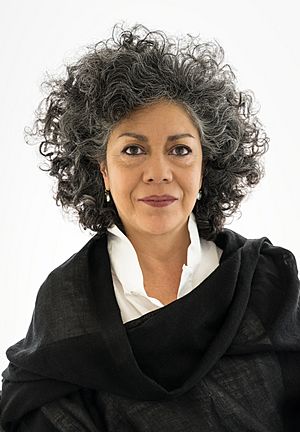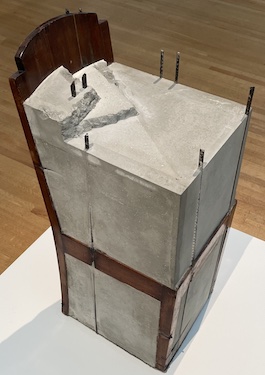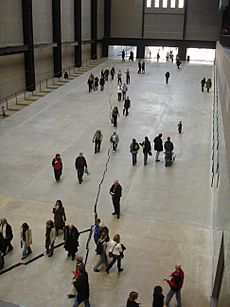Doris Salcedo facts for kids
Quick facts for kids
Doris Salcedo
|
|
|---|---|

Salcedo in 2015
|
|
| Born | 1958 (age 66–67) |
| Education | Jorge Tadeo Lozano University (BA) New York University (MFA) |
|
Notable work
|
Shibboleth (2007) Fragmentos (2018) |
| Movement | Art as Activism |
| Awards | Guggenheim Fellowship (1995) The Ordway Prize, from the Penny McCall Foundation (2005) Commission from Tate Modern, London (2007) Velázquez Visual Arts Prize (2010) Hiroshima Art Prize (2014) |
Doris Salcedo (born in 1958) is a talented artist from Colombia. She creates sculptures and art installations. Her art often uses everyday items like furniture, clothes, concrete, and even rose petals.
Doris Salcedo's work helps people think about pain, sadness, and loss. She creates a space for people to remember and grieve. These ideas come from her own life. Some of her family members were among the many people who went missing in Colombia during times of trouble. Her art explores the deep emptiness left when someone disappears, which is different from mourning a death. Salcedo lives and works in Bogotá, Colombia.
Contents
Early Life and Education
Doris Salcedo was born in 1958 in Bogotá, Colombia. She studied art at Jorge Tadeo Lozano University and earned her Bachelor of Fine Arts degree in 1980. After that, she traveled to New York City to continue her studies. She completed her Master of Fine Arts degree at New York University in 1984.
After finishing her studies, she returned to Bogotá. There, she taught art at the Universidad Nacional de Colombia. She is married to Azriel Bibliowicz, a Colombian writer and sociologist. They both live and work in Bogotá.
Art as a Way to Remember

Salcedo's art often explores how we remember things and how we might forget. In her art installations, she takes ordinary household items. For example, in pieces like Unland: The Orphan's Tunic from 1997, she turns chairs and tables into memorials. These memorials honor people who were affected by the civil conflict in Colombia.
Art expert Andreas Huyssen calls Salcedo's work "Memory Sculpture." He describes how a simple table in her piece Unland can make you think deeply. This table is actually made from two broken tables joined together. It's covered with a thin, whitish fabric. If you look very closely, you can see hundreds of tiny human hairs used as thread to attach the fabric. Huyssen suggests the table represents a body, and the fabric is like skin. This artwork helps people think about a community that has experienced great loss.
Doris Salcedo has explained her artistic process. She says that bringing materials together in art is very powerful. She uses materials that already have meaning from everyday life. Then, she works with them until they change into something new and meaningful.
She also talks about how viewers experience her art. She believes that when someone quietly looks at her work, the feelings of those who suffered can reappear. The art makes the past feel present. It creates a reality that touches each person who sees it. Salcedo uses objects from the past that hold important history. Through her art, she connects the past and the present. She tries to mend what seems broken and helps us understand memory as an ongoing process.
Art Installations

Doris Salcedo's art has increasingly involved creating large installations. She uses art galleries or unusual places to make art that connects to history and important events.
- Remembering a Tragic Event: In 2002, she created Noviembre 6 y 7. This work remembered the 17th anniversary of a violent event at the Supreme Court in Bogotá. For 53 hours, the same amount of time as the original event, Salcedo placed wooden chairs against the building. She lowered them from the roof. She called this an "act of memory" to bring attention back to a forgotten space.
- Chairs in the Street: In 2003, for an exhibition in Istanbul, she stacked 1,500 wooden chairs. They were placed carefully between two buildings on a regular street.
- Changing a Room: In 2005, at the Castello di Rivoli museum, Salcedo changed one of the main rooms. She extended the brick ceiling of the gallery. This subtle change, called Abyss, was meant to make people think about being trapped or enclosed.
- A Crack in the Floor: In 2007, Salcedo created Shibboleth for the Tate Modern gallery in London. It was a 167-meter-long crack running across the floor of the huge hall. Salcedo explained that the crack represents borders and the experiences of immigrants. It shows feelings of being separated or treated differently. She said it represents how people from developing countries might feel when they come to Europe.
Exhibitions
Doris Salcedo's art has been shown in many group exhibitions around the world. These include the Carnegie International (1995), the São Paulo Biennial (1998), and Documenta XI in Kassel (2002). Her work was also part of the 8th Istanbul Biennial (2003) and 'The New Décor' in London (2010).
She has also had many solo exhibitions. These include shows at The New Museum of Contemporary Art in New York (1998), the San Francisco Museum of Modern Art (1999 and 2005), and Tate Britain in London (1999). Her installation “plegaria Muda” traveled to museums across Europe and South America from 2010 to 2013. It was also shown at the Museum of Contemporary Art, Chicago (2015), the Solomon R. Guggenheim Museum (2015), and Harvard Art Museums (2016).
Awards and Recognition
Doris Salcedo has received many important awards for her art:
- 1995 – Guggenheim Fellowship
- 2005 – The Ordway Prize
- 2010 – Velázquez Visual Arts Prize
- 2014 – Hiroshima Art Prize
- 2016 – Inaugural Nasher Prize for Sculpture
- 2017 – Rolf Schock Prizes in Visual Arts
- 2019 – Nomura Art Award
Exploring Important Themes
Since 1988, Salcedo has talked with people whose family members have "disappeared" in Colombia. These disappearances were often linked to the country's civil conflict. She often visits abandoned villages and places where sad events occurred.
Salcedo says her main focus has always been on the effects of violence in society. She has studied how different types of places where people are held against their will have changed over time. She notes that these places, like early concentration camps, have appeared in various forms throughout history.
She has observed how systems that limit people's freedom can make them feel "socially dead." This means they are alive but cannot fully participate in society. Salcedo's art explores what it means to be alive but excluded, like being "dead in life." This is a key idea in her ongoing research.
See also
 In Spanish: Doris Salcedo para niños
In Spanish: Doris Salcedo para niños
- Andreas Huyssen
- Dario Robleto

